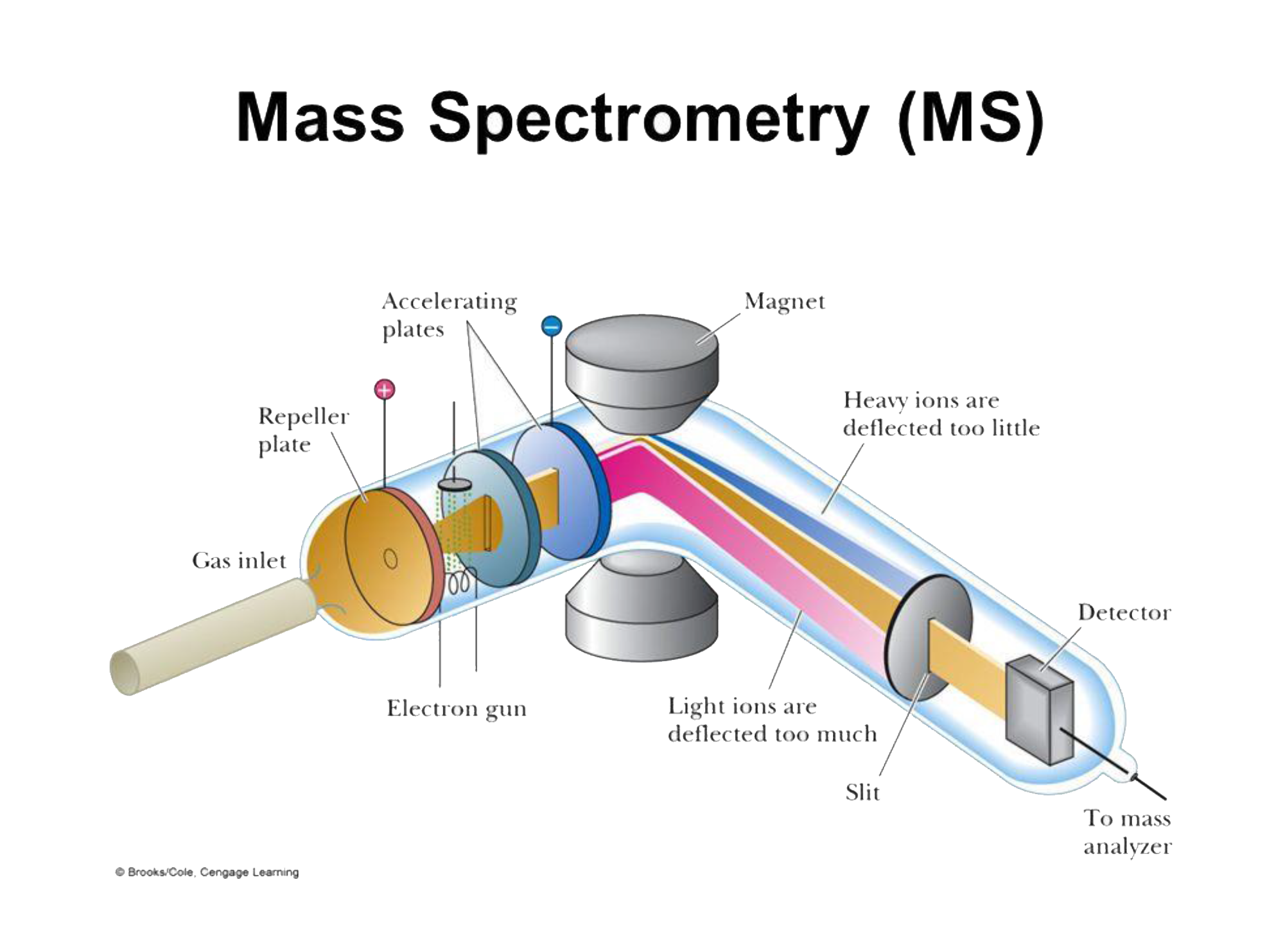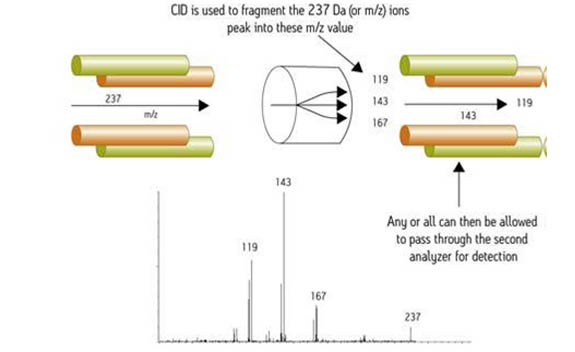Quadrupoles
In 1953, the West German physicists Wolfgang Paul and Helmut Steinwedel described the development of a quadrupole mass spectrometer. Superimposed radio frequency (RF) and constant direct current (DC) potentials between four parallel rods were shown to act as a mass separator, or filter, where only ions within a particular mass range, exhibiting oscillations of constant amplitude, could collect at the analyzer.
Manufacturers' of today's instruments target them for specific applications. Single quadrupole mass spectrometers require a clean matrix to avoid the interference of unwanted ions, and they exhibit very good sensitivity. Triple quadrupoles, or tandem, mass spectrometers (MS/MS) add to a single quadrupole instrument an additional quadrupole, which can act in various ways. One way is simply to separate and detect the ions of interest in a complex mixture by the ions' unique mass-to-charge (m/z) ratio. Another way that an additional quadrupole proves useful is when used in conjunction with controlled fragmentation experiments. Such experiments involve colliding ions of interest with another molecule (typically a gas like argon). In such an application, a precursor ion fragments intoproduct ions, and the MS/MS instrument identifies the compound of interest by its unique constituent parts.
The quadrupole analyzer consists of four rods, which are usually arranged in parallel and made of metal such as molybdenum alloys. A tremendous amount of art and science has been invested in developing quadrupole design. Masses are sorted by the motion of their ions, which direct current (DC) and radio frequency (RF) fields induce into an instrument's analyzer. Systematically changing the field strength via the operating software in effect alters whichm/z value is filtered or transmitted through to the detector at any given time. Quadrupoles yield a lower resolution than some mass spectrometer designs like time-of-flight (TOF) instruments. Yet quadrupoles are relatively simple, easy-to-use, highly utilitarian, instruments that offer a variety of interfaces at a relatively low cost.
Some terminology, more fully defined later in this primer, is necessary for comparing and describing MS capabilities:
Resolving power - Often abbreviated as "res," resolving power is the ability of a mass spectrometer to separate two masses:
- Low res = unit mass = 1000
- Higher or moderate res = 1000 to 10,000
- High res 10,000+
- Very high res = as much as 3 - 5 million
A more detailed examination of resolution and how we measure it appears in the section "Mass Accuracy and Resolution."
Exact Mass is the theoretical exact value for the mass of a compound whereas Accurate Mass is the measured mass value for a compound with an associated error bar like 5ppm. Accurate Mass is also commonly used to refer to the technique rather than the measured mass. Commonly accepted criteria for exact mass work (for instance, to publish in a journal or file a patent) is the ability to derive a measurement on an instrument within 5 ppm of its theoretical mass: 5 ppm at 250 Da is 1.25 mDa (not to be confused with 5 mDa, which would be 20 ppm at 250 Da)
MS/MS - Describes a variety of experiments-multiple-reaction monitoring (MRM) and single-reaction monitoring (SRM). That is monitoring the transition of precursor ions, or fragmentations, to product ion(s), which in general tend to improve the selectivity, specificity, and/or sensitivity of detection over a single-stage-instrument experiment. Two mass analysers in series, or two stages of mass analysis, in a single instrument are used.
In a triple quadrupole mass spectrometer, there are three sets of quadrupole filters, although only the first and third function as mass analyzers. More recent designs have sufficiently differentiated the middle device (replacing the quadrupole of earlier designs) adding increased function so the term or tandem quadrupole is often used instead. The first quadrupole (Q1), acting as a mass filter, transmits and accelerates a selected ion towards Q2, which is called a collision cell. Although in some designs Q2 is similar to the other two quadrupoles, RF is imposed on it only for transmission, not mass selection. The pressure in Q2 is higher, and the ions collide with neutral gas in the collision cell. The result is fragmentation by collision-induced dissociation (CID). The fragments are then accelerated into Q3, another scanning mass filter, which sorts them before they enter a detector.
Fragmentation
Collision-induced dissociation (CID) also referred to as collisionally activated dissociation (CAD), is a mechanism by which molecular ions are fragmented in the gas phase usually by acceleration by electrical potential to a high kinetic energy in the vacuum region followed by collision with neutral gas molecules such as helium, nitrogen or argon. A portion of the kinetic energy is converted or internalized by the collision which results in chemical bonds breaking and the molecular ion is reduced to smaller fragments. Some similar ‘special purpose' fragmentation methods include electron transfer dissociation (ETD), electron capture dissociation (ECD).
Endosulfan-ß Product Ion Spectrum
The 237-Da precursor ion entering on the left was fragmented in the MS/MS collision cell. The data system can display only fragments of interest (not all fragments produced) yielding a relatively simple spectrum with respect to the full scan MS spectrum. You can control the extent of fragmentation as you can the choice of precursor ion.
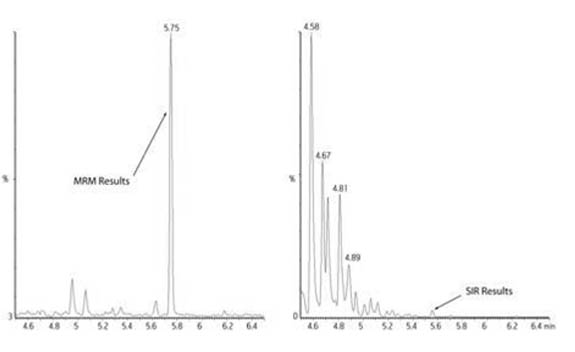
The figure comparing MRM response (left) with SIR response (right) demonstrates how the analyte peak, even when present in solution, may not be determined from SIR data due to chemical background from the matrix. A tandem or triple quadrupole can perform all the experiments of a single quad, so this side-by-side comparison involved no hardware or sample changeover. The same GC/MS/MS instrument was used to filter the 146 m/z butylate ion as a precursor, fragment it to product ions (57 m/z shown) to positively, quantifiably identify its presence. In some regulated industries, to meet the specification for positive compound identification, MRM transitions count for 1.5 "identification points," whereas SIR traces count for 1.0. So, assuming sufficient selectivity, to achieve 3 "IPS," you need 2 MRM transitions but three SIR traces.
Magnetic sector, or a sector field mass analyzer, is an early instrument design that persists today, albeit minimally (having been displaced by modern ESI instruments that can operate in the ESI ionization mode). The Waters AutoSpec, for instance, is used universally for extremely high sensitivity dioxin analysis.
Sectors bend the arc-shaped ion trajectories. The ions' "momentum-to-charge" ratios determine the radius of the trajectories, which themselves are determined by an electric and/or magnetic field. Ions with larger m/z ratios proceed through longer paths than those with smaller ones. The paths are controlled by varying the strength of the magnetic field. Double-focusing mass spectrometers combine magnetic and electric fields in various combinations, although the electric sector followed by the magnetic is more common. This earliest of hybridizations uses the electric sector to focus ions by their kinetic energy as they exit the source. Angular focusing preceded by energetic focusing yields separations of ions with the same nominal mass but different chemical formulas.
Ion traps and other, nonscanning instruments
An ion trap instrument operates on principles similar to those of a quadrupole instrument. Unlike the quadrupole instrument, however, which filters streaming ions, both the ion trap and more capable ion cyclotron (ICR) instrument store ions in a three-dimensional space. Before saturation occurs, the trap or cyclotron allows selected ions to be ejected, according to their masses, for detection. A series of experiments can be performed within the confines of the trap, fragmenting an ion of interest to better define the precursor by its fragments. Fields generated by RF voltages applied to a stacked or "sandwich" geometry (end-cap electrodes at opposing ends) trap ions in space between the two electrodes. Ramping or scanning the RF voltage ejects ions from their secular frequency, or trapped condition. Dynamic range is sometimes limited. The finite volume and capacity for ions limits the instrument's range, especially for samples in complex matrices.
Ion trap instruments were introduced in the 1980s. But limitations imposed by the internal ionization scheme used in those early instruments prevented their use for many applications. Only with the advent of external ionization did the instruments become more universally practical.
The ability to perform sequential fragmentation and thus derive more structural information from a single analyte (i.e., fragmenting an ion, selecting a particular fragment, and repeating the process) is called MSn. GC chromatographic peaks are not wide enough to allow more than a single fragmentation (MS/MS or MS2). Ion trap instruments perform MS/MS or fragmentation experiments in time rather than in space, like quadrupole and sector instruments. So they cannot be used in certain MS/MS experiments like neutral loss and precursor ion comparisons. Also, in MS/MS operation with an ion trap instrument, the bottom third of the MS/MS spectrum is lost, a consequence of trap design. To counter the loss, some manufacturers make available via their software wider scan requirements that necessitate the switching of operating parameters during data acquisition, The trap design places an upper limit on the ratio between a precursor's mass-to-charge ratio (m/z) and the lowest trapped fragment ion, commonly known as the "one third rule". For example, fragment ions from an ion at m/z 1500 will not be detected below m/z 500 - a significant limitation for the de novo sequencing of peptides. The ion trap has limited dynamic range, the result of space-charge effects when too many ions enter the trapping space. Manufacturers have developed automated scanning, which counts ions before they enter the trap, limiting, or gating, the number allowed in. Difficulty can still be encountered when a relatively small amount of an ion of interest is present in a large population of background ions.
Because of similarities in functional design, quadrupole instruments are hybridized to incorporate the advantages of streaming quadrupole and ion trapping behavior to improve sensitivity and allow on-the-fly experiments not possible with either alone. Such instruments are sometimes called linear traps or Q-traps). The increased volume of a linear trap instrument (over a three-dimensional ion trap) improves dynamic range.
Ion trap instruments do not scan as a quadrupole instrument does so using the single ion monitoring (SIM), or single ion recording (SIR), technique does not improve sensitivity on ion traps as it does on quadrupole and sector instruments.
Fast-fourier transform ion cyclotrons (FTICR) represent the extreme capability of measuring mass with the ability to resolve closely related masses. Although impractical for most applications, a 14.5-tesla magnet can achieve a resolution of more than 3.5 million and thus display the difference between molecular entities whose masses vary by less than the mass of a single electron.
Cyclotron instruments trap ions electrostatically in a cell using a constant magnetic field. Pulses of RF voltage create orbital ionic motion, and the orbiting ions generate a small signal at the detection plates of the cell (the ion's orbital frequency). The frequency is inversely related to the ions' m/z, and the signal intensity is proportional to the number of ions of the same m/z in the cell. At very low cell pressures, a cyclotron instrument can maintain an ion's orbit can for extended periods providing very high resolution measurements.
Sustained off-resonance, irradiation, collision-induced dissociation (SORI-CID) is a CID technique used in Fourier-transform ion cyclotron resonance mass spectrometry. The ions are accelerated in cyclotron motion where increasing pressure results in collisions that produce fragments. After the fragmentation, the pressure is reduced and the high vacuum restored to analyze the fragment ions.
Time-of-flight (TOF) instruments, although developed many years ago, have become the basis for much modern work because of their fast, precise electronics and modern ionization techniques like ESI. A TOF instrument provides accurate mass measurement to within a few parts-per-million (ppm) of a molecule's true mass. A temporally dispersive mass analyzer, the TOF instrument is used in a linear fashion or, aided by electrostatic grids and lenses, as a reflectron. When operated as a reflectron, resolution is increased without dramatically losing sensitivity or needing to increase the size of the flight (or drift) tube.
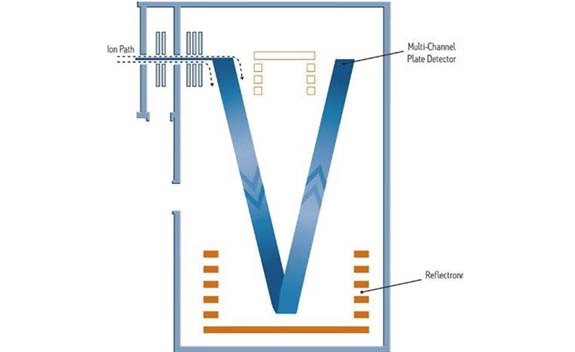
Ions are accelerated by a high voltage pulse into a drift or flight tube. Lighter ions arrive at the multi-channel plate (MCP or detector) sooner than heavy ones.
TOF analyses involve accelerating a group of ions, in a brief burst, to a detector. The ions exit the source, each having received from a "pusher" electrode an identical electrical charge, or potential. Each ion's potential accelerates, or fires, it into a very low pressure tube. Because all similarly charged ions share the same kinetic energy (kinetic energy = ½ mv2 where m is the ion mass and v the velocity), those with lower masses evidence greater velocity and a lesser interval before striking the detector. Since mass, charge, and kinetic energy determine the arrival time of an ion at the detector, the ion's velocity can be represented as v = d/t = (2KE/m)1/2. The ions travel a given distance (d), in time (t), where t depends on the mass-to-charge ratio (m/z). Since all masses are measured for each "push," the TOF instrument can achieve a very high sensitivity relative to scanning instruments.
Today, quadrupole MS systems scan routinely at 10,000 Da, or amu, per second. So a comprehensive scan, even one of short duration-an LC or GC peak of 1 second, for instance-would nevertheless capture each ion 10 times, or more, in each second. The TOF instrument's detector registers ions bombarding the plate within nanoseconds of each other. Such resolution offers the added capabilities of a wide dynamic range and greater sensitivity when compared directly to a scanning instrument such as a quadrupole. Yet the quadrupole instrument is, generally speaking, more sensitive when detecting target analytes in complex mixtures and is,therefore, typically a better quantitation tool. Some instruments, like ion traps, offer a combination of these capabilities. But until the advent of hybrid instruments, no single one could deliver high-order performance in all aspects.
Early MALDI-TOF designs (using matrix assisted laser desorption ionization) accelerated the ions out of the ionization source immediately. Their resolution was relatively poor and their accuracy limited. Delayed extraction (DE), developed for MALDI-TOF instruments, "cools" and focuses the ions for approximately150 nanoseconds after they form. Then it accelerates the ions into the flight tube. The cooled ions have a lower kinetic-energy distribution than uncooled ones, and they ultimately reduce the temporal spread of the ions as they enter the TOF analyzer, resulting in increased resolution and accuracy. DE is significantly less advantageous with macromolecules (for instance proteins >30,000 Da).
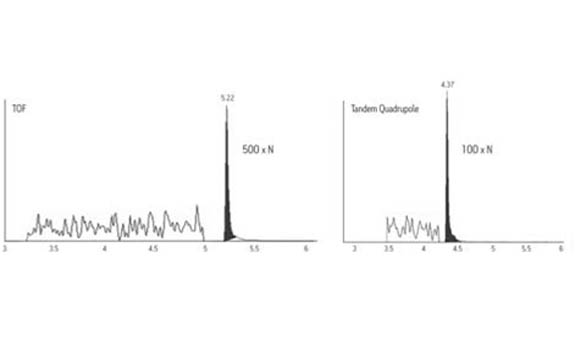
A fivefold-to-tenfold advantage in scanning mode sensitivity is demonstrated by the TOF over the QQQ. These data are from the same sample aliquot. However, the autosampler used with the TOF instrument was fitted with a 5 uL syringe. The autosampler used with the triple quadrupole instrument was fitted with 10uL syringe. So respective injections of 0.5 and 1.0uL were performed.
Hybrids
The term "hybrid" applies to various mass spectrometer designs that are composites of existing technologies such as double-focusing, magnetic sectors and, more recently, ion traps that "front" cyclotrons. One of the most interesting designs, the quadrupole time-of-flight (QTOF) mass spectrometer, couples a TOF instrument with a quadrupole instrument. This pairing results in the best combination of several performance characteristics: accurate mass measurement, the ability to carry out fragmentation experiments, and high quality quantitation.
Data Handling
You can sum the intensities of ions, and plot them as a function of time (chromatographic retention time) for a total ion chromatogram (TIC), which looks much like the output of a spectrophotometer such as a UV detector. In the case of MS, one axis represents ion intensity; the other can be time or the digital sample taken at a particular time (i.e., a spectrum). You can display each of the spectra can separately, much like a series of images acquired by modern digital video cameras that are, in essence, a series of high speed still photos.
Simple but very useful techniques are possible: for example, reducing the array of data in a selected ion chromatogram or applying digital filters to reduce noise, as you could by displaying only the most intense peak of each digital sample (a base peak ion chromatogram, or BPI).
Data output, storage and retrieval
Software design has become a separate specialty over the years, not simply a means to set acquisition parameters. Today, operating and data systems permit intricate control of an instrument by its operator.
Significantly, these specialty software packages have evolved:
Workflow controls such as open access (also called 'walk-up systems) - a fully trained operator can make complete LC or GC/MS methods available to a large number of non-specialist users giving them access to advanced technology without the requirement for extensive training. A non-specialist may only need to make occasional use of an instrument for determining a compound's identity or purity. The system allows them access without first becoming proficient operators themselves.
Data reduction applications - These packages for instance may help identify metabolites or develop biomarkers in complex mixtures from the thousands of unique chemical entities. The applications are often augmented by "expert" systems such as principal component analysis software (PCA), which examines trends not otherwise visible in the extensive output.
The demands of data management are fast outstripping the ability to meet them. High resolution, mass-accurate data can generate a prodigious 1 GB/h. Such enormous quantities of data are generated not only by life science investigators but, increasingly, by those working in industries that depend on high volume processes like characterizing the presence of metabolites and their biotransformations. After 180 days of operation, five mass spectrometers, each producing 24 GB of data per day, will present you with the need to store, retrieve, sort, and otherwise make sense of 21.6 terabytes (TB).
The first question in any data scenario must address what we intend to do with the data we collect. Unlike e-mail, which imparts its message and thereafter serves little purpose, online data increases in value over time as biological, pharmaceutical, and physicochemical measurements continue to amass within a data file. But this increase in value comes with the cost of ensuring the data's accessibility. In view of the increasing size of data files, and the length of time over which they must be accessed, a solution might include some form of hierarchical storage management. Thus, some smaller percentage of the data would be immediately accessible, or "active," while the remainder, in successive stages, are in-process or earmarked for long-term archiving.
Mass Accuracy and Resolution
Increased, measured mass accuracy and resolution is now a dominant tool for structural characterization in various applications beyond early drug discovery. With their broad reach of specificity and utility, quadrupole time-of-flight (QTOF) instruments, offered by a number of manufacturers today, are replacing other LCMS technologies.
Even though higher order instruments exist, a QTOF instrument’s high mass accuracy falls within a few parts per million of the true, calculated, monoisotopic value, and its high resolution—as much as 10 times higher than a quadrupole instrument’s—permits us to determine empirical formulas according to mass defect (where the critical mass value of hydrogen and other atoms present serve as a differentiator). Speciation analysis—discerning the difference between an aldehyde and a sulphide, for example—becomes possible with an increase in mass accuracy above the quadrupole limits to 30 ppm, where the two masses differ by 0.035 Da. Differentiation between the metabolic processes involving methylation is more demanding, however. Adding CH2 produces an increase over the precursor (response for the drug alone) in the measured mass of +14.0157 Da, as compared with a two-stage biotransformation involving hydroxylation (addition of oxygen) followed by oxidation at a double bond (loss of H2), which produces an increase of +13.9792 Da. Yet both measurements, when limited by nominal resolution—a typical quadrupole response—will look like +14 Da.
High mass-accuracy and low resolution
Low resolution quadrupole instruments perform well for extremely high mass-accuracy measurements, like those used for analyzing proteins. The masses of proteins are generally defined as “average” values when the isotope peaks are not resolved relative to each other. Average mass is the weighted mean of all the isotopic species in a molecule. The instrumental resolution normally employed on quadrupole instruments broadens the resolved response for a 10 kDa protein by a factor of x1.27. That factor increases significantly as the mass increases (for example, to x2.65 at 100 kDa). However, by reducing the peak width to m/z 0.25 (increasing resolution to 4000 resolution) rather than limiting the instrument resolution to 1000 using the typical peak width (m/z 0.6) improves the situation dramatically.

